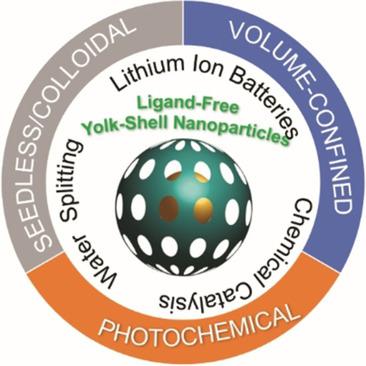当前位置:
X-MOL 学术
›
ChemNanoMat
›
论文详情
Our official English website, www.x-mol.net, welcomes your
feedback! (Note: you will need to create a separate account there.)
Ligand‐Free Yolk‐Shell Nanoparticles: Synthesis and Catalytic Applications
ChemNanoMat ( IF 2.6 ) Pub Date : 2020-07-20 , DOI: 10.1002/cnma.202000354 Firdoz Shaik 1, 2
ChemNanoMat ( IF 2.6 ) Pub Date : 2020-07-20 , DOI: 10.1002/cnma.202000354 Firdoz Shaik 1, 2
Affiliation

|
Ligand‐Free yolk‐shell nanoparticles (LFYSNs) consist of ligand‐free core (nanoparticle) enclosed in a hollow nanocavity of a porous shell have been attracted great interest owing to their unique nanoarchitecture features, enchanting physicochemical properties and extensive potential applications. LFYSNs are considered as a unique category of conventional yolk‐shell nanoparticles (YSNs). YSNs are usually consist of organic‐capped core (nanoparticle) and the presence of capping ligands on the surface of metal core may show deleterious effects in catalytic applications. Here, a comprehensive overview on the recent progress of LFYSNs synthetic strategies and catalytic applications are discussed. The fabrication methods for LFYSNs are mainly focused on a ‘‘ship‐in‐a‐bottle/pre‐shell’’ approach and sub‐divided into three categories, including volume confined, photochemical and seedless/colloidal methods. The catalytic applications of LFYSNs including chemical and photo catalysis, and electrocatalysis are discussed in detail. Moreover, the superlative catalytic activity of LFYSNs is highlighted. Finally, perspectives on future research direction and development of LFYSNs are discussed briefly.
中文翻译:

无配体的卵黄壳纳米粒子:合成和催化应用。
无配体卵黄壳纳米颗粒(LFYSN)由封闭在多孔壳中空纳米腔中的无配体核(纳米颗粒)组成,由于其独特的纳米结构特征,迷人的理化特性和广泛的潜在应用而备受关注。LFYSN被认为是常规卵黄壳纳米颗粒(YSN)的独特类别。YSN通常由有机封端的核(纳米粒子)组成,金属核表面上存在封端配体可能在催化应用中显示出有害作用。在这里,对LFYSNs合成策略和催化应用的最新进展进行了全面概述。LFYSN的制造方法主要集中于“瓶装/预装船”方法,并细分为三类,包括体积限制,光化学和无籽/胶体方法。详细讨论了LFYSN的催化应用,包括化学和光催化以及电催化。此外,突出了LFYSNs的最高级催化活性。最后,简要讨论了LFYSNs的未来研究方向和发展前景。
更新日期:2020-07-20
中文翻译:

无配体的卵黄壳纳米粒子:合成和催化应用。
无配体卵黄壳纳米颗粒(LFYSN)由封闭在多孔壳中空纳米腔中的无配体核(纳米颗粒)组成,由于其独特的纳米结构特征,迷人的理化特性和广泛的潜在应用而备受关注。LFYSN被认为是常规卵黄壳纳米颗粒(YSN)的独特类别。YSN通常由有机封端的核(纳米粒子)组成,金属核表面上存在封端配体可能在催化应用中显示出有害作用。在这里,对LFYSNs合成策略和催化应用的最新进展进行了全面概述。LFYSN的制造方法主要集中于“瓶装/预装船”方法,并细分为三类,包括体积限制,光化学和无籽/胶体方法。详细讨论了LFYSN的催化应用,包括化学和光催化以及电催化。此外,突出了LFYSNs的最高级催化活性。最后,简要讨论了LFYSNs的未来研究方向和发展前景。











































 京公网安备 11010802027423号
京公网安备 11010802027423号